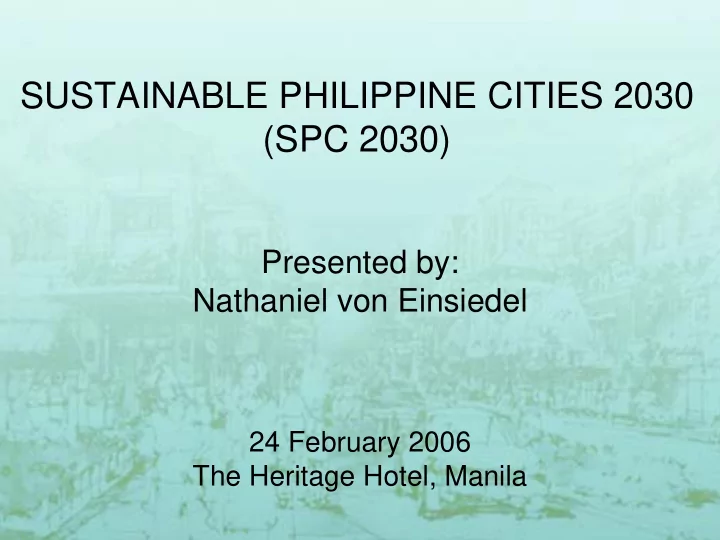

SUSTAINABLE PHILIPPINE CITIES 2030 (SPC 2030) Presented by: Nathaniel von Einsiedel 24 February 2006 The Heritage Hotel, Manila
Sustainable Philippine Cities 2030 . . . A multi-sectoral and interdisciplinary inquiry into issues of sustainable urbanization, the necessary actions to address these, and the corresponding performance targets over the next 25 years. . . . A multi-authored publication on how to make Philippine cities and towns more sustainable in social, economic and ecological terms. . . . An initiative of the Philippine Urban Forum (PUF).
Chapter Preparation Structure Chapter Convenor/ Editor Civil Society National Local Private Organization / Government Government Business Academe Agency Representatiave
Chapters and Convenors 1. Urban Society – Institute of Church and Social Issues (ICSI) Urban Social Services – Urban Research Consortium 2. (URC) 3. Urban Economy – Asian Institute of Management (AIM) Urban Planning and Settlement Patterns – Philippine 4. Institute of Environmental Planners (PIEP) / Human Settlements Foundation (HSF) 5. Urban Shelter – Philippine Partnership of Support Service Agencies (PHILSSA) / Subdivision and Housing Developers Association (SHDA) Urban Transport – Transport Science Society of the 6. Philippines (TSSP)
Chapters and Convenors (con’t.) 7. Water and Sanitation – Philippine Association of Sanitary Engineers 8. Urban Environment – Management Association of the Philippines (MAP) / Philippine Business of the Environment (PBE) 9. Building Design and Management – United Architects of the Philippines (UAP) - Green Architecture Forum 10. Disaster Management – Philippine Disaster Management Forum 11. Energy – Energy Management Association of the Philippines (EMAP) 12. Urban Governance – League of Cities of the Philippines (LCP) / Galing Pook Foundation
Expected Outputs 1. Publication in book form – in 18 months - Issues - Strategies / Tools - Performance Targets 2. Web-based E-book – in 24 months - Issues - Strategies / Tools - Performance Targets - City Sustainability Plans - Best Practices - Links to related websites
Urban Sector Roadmap Millennium Development Goals (MDGs) Goals Targets Indicators 1. Proportion of population below $1/day (I1) 1. Halve, between 1990 and 2015 1. Eradicate the proportion of people whose 2. Poverty gap ratio (I2) Extreme Poverty income is less than $1/day (PPP, and Hunger (G1) 1985) (T1) 3. Share of poorest quintile in national consumption (I3) 10. Halve, by 2015, the proportion of 29. Proportion of population people without sustainable access to with sustainable access to improved water source (I29) safe drinking water (T10) 7. Ensure Environmental 30. Proportion of people with 11. By 2020, to have achieved a Sustainability access to improved sanitation significant improvement in the lives (G7) (I30) of at least 100 million slum dwellers 31. Proportion of people with (T11) access to secure tenure (I31)
Urban Sector Roadmap (con’t.) Indicators Sector - N Years Ago Current + N Years Profile Remarks Total Urban % Total Urban % Total Urban % Population Urban Urban Urban Urban No. % No. % No. % Remarks Hierarchy Pop’n Pop’n Pop’n • megacities • primary cities • secondary cities • medium & small towns
Urban Sector Roadmap (con’t.) Indicators MDG Sector Outcomes - N Years Linkage Current + N Years Remarks Ago lower incidence of urban poverty G1, T1, urban poverty incidence is x% of total urban I1 pop’n living below poverty line increase sustainable access to safe G7, T10, urban pop’n w/ sustainable access to safe drinking water for urban pop’n I29 drinking water is y% of total pop’n increase sustainable access to safe G7, T11, proportion of solid waste collected, expressed I30 as a% of total solid waste generated sanitation for urban pop’n G7, T11, proportion of urban pop’n living in informal reduce the proportion of people living I31 housing structures is h% of total pop’n in informal dwellings Proportion of urban pop’n occupying land w/o increase the proportion of people w/ G7, T11, formal agreement or security of tenure is s% I31 secure tenure of total pop’n reduce the area of urban land affected average a ha. Are flooded to a depth of M G7, T11, by flooding meters for a duration of T hours, N times per I30 year (i) Length of urban distribution & access road improve mobility & access particularly that is in good condition is R% of total length for the urban poor of urban road G1, T1, (ii) During peak hour a typical journey by I2, I3 public transport of k km takes t minutes (iii) D% of daily wage (USD$) is spent for travel cost
Urban Sector Roadmap (con’t.) Checklist Sector Issues & Constraints Yes No Remarks Urban governance system is in place which helps to create conditions that are conducive to conducting business, providing jobs and creating livelihood opportunities. Policy environment and regulatory framework are in place which enables public utility service providers in the water and sanitation industries to deliver efficient and effective services. Urban land management policies and strategies are in place that ensure an adequate supply of affordable land for low income housing. Housing management financing policies are in place to enable people to regularize their tenure. Policies are in place that encourage private sector participation in the provision of shelter and public services. Policies are in place that ensure appropriate and adequate flood control facilities. Policies are in place that enable the responsible authorities to improve and maintain roads, introduce traffic management strategies and improve public transport services.
Urban Sector Roadmap (con’t.) By Agency Actions/ Milestones/ Investment Timeframe External Government Agencies City Development Strategy Slum Eradication Strategy and Program Shelter Strategy and Program Water Supply Improvement Program Sanitation Improvement Program Solid Waste Management Plan and Program Drainage Master Plan and Program Infrastructure Maintenance Plan and Program; Inventory of Road Condition and Rehabilitation Strategy Traffic Management Plan Others
Thank you for your attention.
Recommend
More recommend